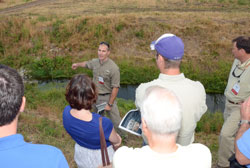 Water quality was the theme of the 2012 Conservation in Action Tour stop where we met Robbie Kroger, Mississippi State University. You’ll notice a drainage ditch in the photo. After some opening remarks we got down there to see some of the creative ways that this farm is managing runoff water using pipes, pads and weirs.
Water quality was the theme of the 2012 Conservation in Action Tour stop where we met Robbie Kroger, Mississippi State University. You’ll notice a drainage ditch in the photo. After some opening remarks we got down there to see some of the creative ways that this farm is managing runoff water using pipes, pads and weirs.
Robbie says the Delta region typically gets nearly 60 inches of rain and sometimes up to 6 inches in a three hour period. He says the region is rich in topsoil. In fact, the topsoil at the spot we were standing on was almost 24 feet deep. Typically farmers in the area don’t apply any phosphorous. He says the area has one of the highest sediment loss rates in the country. All the practices he spoke about were structural to hold back sediment from draining off the farm. It’s called controlled surface drainage. Precision ag and input management is very big. Land leveling is the highest requested cost share practice in the region. Pads and pipes are important. Pads are the raised area around a field after land leveling which allows the channeling of water runoff. Pipes are used to convey the water. Finally there’s drainage, hence the ditch you see in the photo.
Listen to my Robbie’s remarks before getting down in the ditch here: Robbie Kroger Remarks
2012 Conservation in Action Tour Photo Album
AgWired coverage of the CTIC Indian Creek Watershed Field Tour is sponsored by AGROTAIN